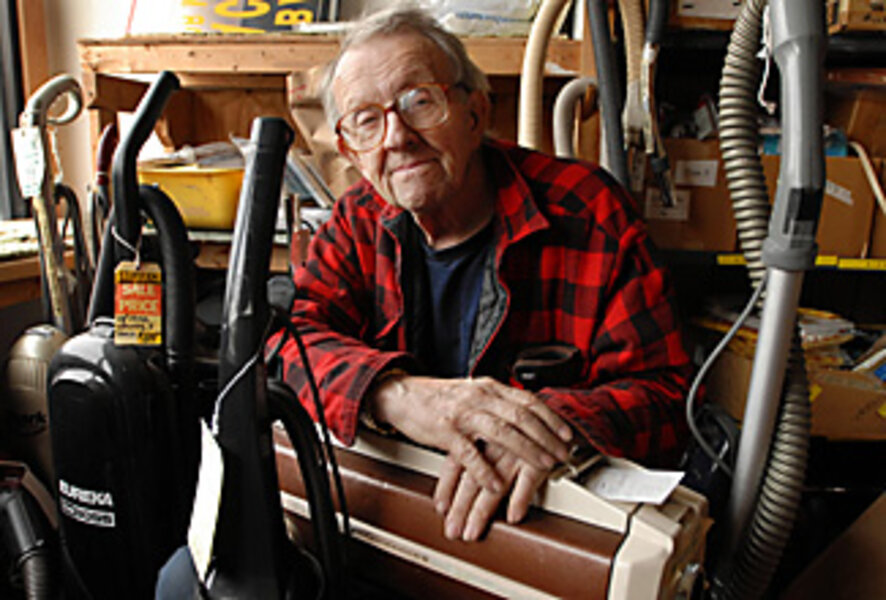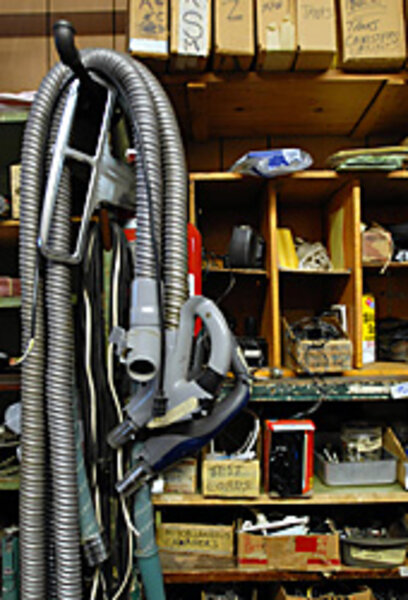The vacuum repair guy: an endangered species
Loading...
| Natick, Mass.
We all have a vacuum cleaner story. It might not be as dramatic as my friend Lisa Foote's, whose family ferret was successfully removed from an Electrolux attachment by emergency greasing. It might not be as heartwarmingly odd as my husband's, whose best friend at the age of 4 was "Vac," the second-hand Hoover he took everywhere with him – including the car. But for most of us, the family vacuum cleaner was more than a major purchase; it was a family fixture. Repaired and re-repaired, it was rarely thrown away.
All that has changed, says John Huling, hero of three generations of my own family's vacuum cleaner stories and an emblem of a dwindling breed – the vacuum repairman.
"The mentality of people has changed.... It's easier to go buy a vacuum cleaner than it is to take it to a repair shop," laments Mr. Huling, who closed his doors last week after more than 50 years in the business of repairing vacuum cleaners. He claims to have been edged out by multiple forces, including inaccessibility of parts, changes in manufacturing, and what he describes as today's "throwaway" culture.
On a recent morning, he reminisced with me as he made his final sales and fixes. Judging from the steady stream of patrons seeking last minute advice and wishing him well, I'm not the only one feeling bereft.
"I'm gonna be up the creek," clucks a woman with a German accent, coddling an ancient Electrolux bearing an array of Huling's repair stickers – evidence of a decades-long relationship. "He doesn't cheat you," she says, elaborating on the number of times Huling stopped her from buying a new vacuum in favor of repair.
Huling nods matter-of-factly. "I've found it's easier to just tell it like it is, and then you don't have to wonder, 'What did I tell that person last week? Did I tell them they needed to buy a new one? The big companies want to sell you a new one.... A guy in a shirt and tie shows you a nice, new $300 machine so you take out your ... credit card and pay for it."
Huling, who never took credit cards, allowed customers caught without cash or check to pay him later. "I only got stung once, for 12 bucks."
He sighs as a woman comes in with a new machine. Politely referring her elsewhere, he confides, "It's a piece of junk, speaking technically ... that [machine] was made by the company that made the best vacuum cleaner that was ever made and then they switched to plastic."
The way he utters the word leads me to ask about the evils of plastic. His excited cadences take me back to childhood visits when – dislodging socks or Barbie clothes from a clogged hose – he'd counsel my mother on the need for careful attention. "You can't fix half the new vacs," he says. "Everything's plastic now, even the lever that releases the handle that you have to step on every day.... They snap off. By the time I order the parts and charge labor to repair it, you don't want to do it. I'm just waiting for them to tell me they can't fix my car someday!"
• • •
When the first motorized upright vacuum cleaner was patented by William Hoover in 1908, each screw and bolt was replaceable, says Robert Kautzman, an Albertus, Penn., historian and owner of the largest private vacuum cleaner collection in the US. The original Hoover upright was made of wood and tin but closely resembles today's uprights in design – including its fan motor and horsehair roller brush, he explains.
Advertised in magazines as a more sanitary, convenient cleaning mode than outdoor carpet beating, 300 Hoovers were sold the first year. Within a decade, names such as Royal and Eureka had helped bump annual sales to 300,000. "This is all the more remarkable when you consider that only 10 percent of American households had electricity," marvels Mr. Kautzman. "There were no wall plugs either. The cord had to be plugged into a light bulb socket."
By the 1930s, he says, a significant reduction in the weight and cost of a machine made it more practical. Though vacuums were "widespread" by the 1950s, he says, it was a significant purchase, motivating careful maintenance and repair.
By the late 1980s some manufacturers had reduced the machine to seven component plastic parts, says Kautzman, whose virtual museum – vachunter.com – displays his 1,500 machines, dating back as far as the crank models of the 1860s.
Plastics reduced costs for manufacturers but made the machines difficult to take apart, he says. [They] work as well as the old ones and they're cheaper. [But] they're not as durable and you can't repair them."
• • •
Huling's hunched shoulders straighten and his downtrodden expression lightens for a moment as he points out a favorite Electrolux in his dusty window: "That vac will be around long after we are. It's 30 years old. Some of them along the corner here are 40 years old. There's no vac made today that's going to be here 40 years from now."
Motioning to his continually ringing phone, he says, "This lady's calling me now because she can't get in during my hours." Huling says he can't compete with mall hours to accommodate today's frantic schedules.
"I need to sit," says the next in line – an elderly woman who perches on a stool in front of the counter. She's in search of a bag for her vacuum cleaner, whose model number she's forgotten.
"Was the machine yellow?" asks Huling.
Even before she answers in the affirmative, he has retrieved a special bag from a high shelf. He refuses payment, and the woman sums up what this man has meant to her: "I could come down and say, 'This is my problem. What do I do?' "
This is a question Huling, who has been fixing things ever since discovering his aptitude in an eighth grade "manual training" class, has been asking himself recently. "Working with my hands ... that's all I ever did," he says. "I could figure anything out." While attending Wentworth College in Boston, he worked for a watch hospital, but opened his own repair business in 1953.
Huling's wife, Theresa, has helped out in the shop during recent budget-cutting years. She, and the seven children they raised a block away, are the reason behind his chosen profession: "I could name my hours ... so when the kids were growing up, if one of my sons was in a play, I could break for a couple of hours and go over."
Now, he says, with a rueful smile, "My kids are all more loaded than I am. But they also get up every morning at 6 o'clock and go to work, which I could never do."
Though he doesn't regret his career choice, he admits he's envious of his children's retirement plans. His oldest son recently retired as a trombonist for the Washington National Symphony and the others work in what he describes as corporate settings. He has known for a long time that he wouldn't be handing down the family business.
• • •
Before the morning is over, Huling offers advice to the mother of an asthmatic child and spends a good amount of time with a man who has inherited a vacuum from his mother. Huling demonstrates how to remove the power brush wound around with shag carpeting. This leads to a story about a customer whose son purposely sucked up his mother's throw rug every time he was asked to vacuum.
A blizzard is reportedly blowing in, so Huling decides to close shop early.
I stall – not ready to face a future devoid of one man's affection for the beauty of well-made machinery. Before leaving the musty, memory-filled store, I ask what has been most satisfying for him: repairing machinery or helping people.
Without hesitation he answers, "The person that I fix things for usually appreciates it. The machine doesn't care whether it's fixed or not. A vac is a vac."






